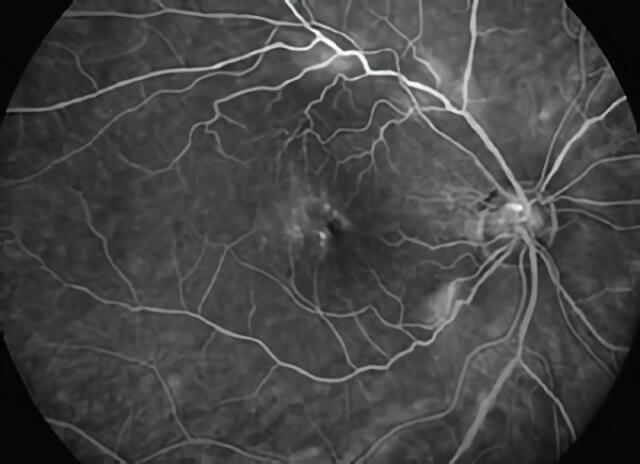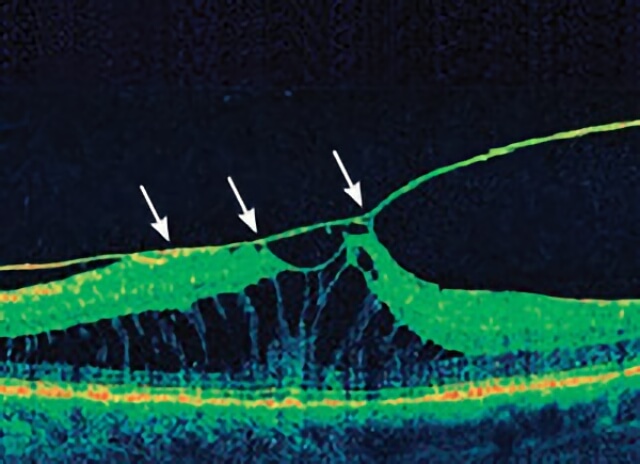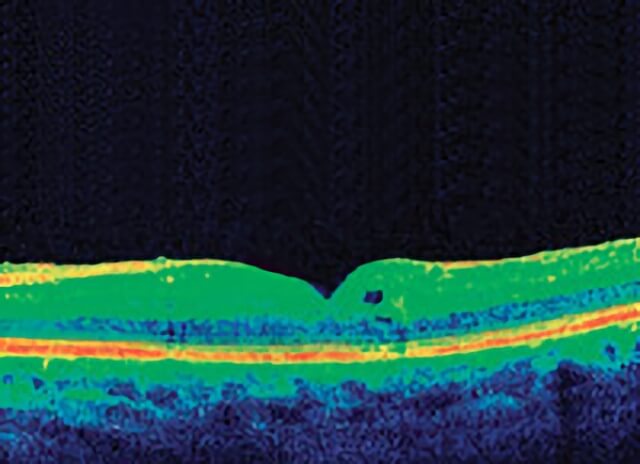Vitreomacular Traction
What is vitreomacular traction?
The macula is the small area at the center of the retina, which is the thin tissue that lines the inside of the back of the eye. The macula is the most sensitive part of the retina. It is the macula that gives us the vision we use to read and to do detailed visual tasks. As we grow older the thick vitreous gel that fills the eye shrinks and pulls away from the macula. Sometimes as the vitreous pulls away from the macula, it remains partially stuck and pulls on the surface. This pulling and distortion of the normal macular structure is called vitreomacular traction (VMT).

Fluorescein angiogram image in a patient with VMT, showing distortion of the retinal blood vessels and white “clouds” indicating fluid accumulation in areas of traction, especially in the center and upper portion of the image.
Learn more about vitreomacular traction (VMT) at ASRS
Información en español en el sitio web de ASRS
What causes VMT?
The vitreous gel shrinks and pulls away from the macula at different rates in each person, but it occurs in everyone with time. VMT only occurs when there is an abnormally tight adhesion between the shrinking gel and the macula.
How is VMT diagnosed?
A careful retinal examination can reveal signs of VMT, including distortion and elevation of the retina and fluid accumulation within areas of stretched retina. Specialized tests such as a photographic assessment of the retinal blood flow after injection of an intravenous dye called a fluorescein angiogram and a computerized optical scan of the retina called an OCT can help in making the diagnosis and in determining the severity of VMT.

An OCT image of VMT before surgery, showing upward traction on the macula from elevation of the vitreous gel (arrows).
How does VMT affect the vision?
VMT may cause no symptoms at all in its mildest forms. Sometimes, VMT worsens and the increased traction results in blurred or distorted central vision.
How is VMT treated?
In cases of VMT where the vision is unaffected, no treatment may be necessary. Follow up examinations are necessary to monitor for worsening of the condition. Sometimes as the vitreous gel continues to shrink, its adhesion to the macula will release and the VMT will resolve without treatment. More commonly, as the gel shrinks the vision worsens and a surgery called a vitrectomy will be recommended to release the traction. This painless surgery is performed as an outpatient procedure (no overnight hospital stay) under local anesthesia with sedation. During the surgery, microscopic instruments are inserted into the eye to release all adhesions of the gel to the macula, to remove the vitreous gel, and to peel away any residual membranes on the surface of the macula that may also be contributing to distortion of the vision. Sometimes the eye is filled with a gas at the end of surgery to help with healing. If used, the gas slowly disappears over days to weeks.
Will my vision improve after surgery for VMT?
How much vision is restored after surgery for VMT generally depends on the severity of the condition and how long it was present before surgery. Not all patients regain sight and many patients do not return to completely normal vision, even after successful surgery. However, most patients who have surgery for VMT usually regain some of the lost sight slowly over weeks to months after surgery.

OCT after surgery, showing return of a more normal macular appearance after removal of the gel.
Schedule Vitreomacular Traction Treatment in Northern California with Retinal Consultants Medical Group
Since 1975, Retinal Consultants Medical Group has been providing outstanding care to patients throughout Northern California, including Sacramento, Modesto, and Stockton. Our retina specialists and surgeons treat multiple vitreoretinal conditions, such as age-related macular degeneration and diabetic retinopathy. We invite you to contact us with any questions or schedule an appointment today.


